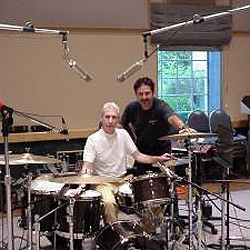If you’re doing a session in Los Angeles and you want your drums to instantly sound great, then your first call is to the Drum Doctors to either rent a fantastic sounding kit, or have your kit tuned.
Ross Garfield is the “Drum Doctor” and you’ve heard his drum sounds on platinum recordings from Bruce Springsteen, Rod Stewart, Metallica, Dwight Yokum, Red Hot Chili Peppers, Foo Fighters, Lenny Kravitiz, Michael Jackson and many, many more.
Ross was kind enough to sit down for an interview when I wrote The Recording Engineer’s Handbook, but I’ve featured some of his tips in other books as well including The Drum Recording Handbook, The Touring Musician’s Handbook, and The Music Producer’s Handbook.
So, I like to think his tips are worth sharing! Here are a few of his quick drum tuning tips, which can be lifesavers if you’re new to tuning drums.
If the snares buzz when the toms are hit:
• Check that the snares are straight.
• Check to see if the snares are flat and centered on the drum.
• Loosen the bottom head.
• Retune the offending toms.
If the snare drum has too much ring:
• Tune the heads lower.
• Use a heavier head like a coated CS with the dot on the bottom or a coated Emperor.
• Use a full or partial muffling ring.
• Have the edges checked and/or recut to a flatter angle.
If the kick drum isn’t punchy and lacks power in the context of the music:
• Try increasing and decreasing the amount of muffling in the drum, or try a different blanket or pillow.
• Change to a heavier, uncoated head like a clear Emperor or PowerStroke 3.
• Change to a thinner front head or one with a larger cutout.
• Have the edges recut to create more attack.
If one or more of the toms are difficult to tune or have an unwanted “growl”:
• Check the top heads for dents and replace as necessary.
• Check the evenness of tension all around on the top and bottom heads.
• Tighten the bottom head.
• Have the bearing edges checked and recut as required.
If the floor tom has an undesirable “basketball-type” after-ring, try this:
• Loosen the bottom head.
• Check the top heads for dents and replace as necessary.
• Loosen the top head.
• Switch to a different type or weight top or bottom head like a clear Ambassador or Emperor).
• Have the bearing edges recut to emphasize the lower partials.
If the cymbals are cracking or breaking with greater frequency, try the following:
• Always transport the cymbals in a top-quality, reinforced cymbal case or bag to avoid nicks that can become cracks.
• Use the proper cymbals felts, washers and sleeves at all times.
• Avoid over-tightening the cymbal stand.
• Use larger or heavier cymbals that you won’t have to overplay to hear.
Hopefully these tips are useful to you in your next session!
Bobby Owsinski is an author, producer, music industry veteran and technical consultant who has written numerous books covering all aspects of audio recording. For more information be sure to check out his website and blog.
















